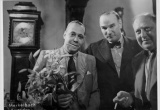The Summer of 1936
De Jantjes ushered in a short-lived boom in Dutch feature film production. The film was based on a popular comedic Dutch play. It cast well-known revue stars in the leading roles and was a big hit. About 1.2 million tickets were sold, making it the best-attended film in the Netherlands in the pre-WWII period.
This success spurred others to follow suit and within about two years, more films using the same formula as De Jantjes were produced. These were farcical, sometimes vulgar stories that usually played out against the background of the working or merchant class. The films were filled with songs and well-known stars. Most films were recorded at Cinetone Studios in Duivendrecht.
Formula films
But the tide turned quickly for Dutch formula films such as these. While the press was still positive about the quality of De Jantjes and was forgiving of its shortcomings, it was much less tolerant of the film’s successors. Their flaws were unfailingly laid bare and every one of the weak stories were rejected. The criticism was aimed especially at the producers and financiers who placed financial gain above the artistic quality.
The critics defended their position by saying that it was partly their task to help Dutch film to reach a higher level and that it was precisely their responsibility to look extra critically at the results achieved. Only a few films were deserving of mercy in their eyes; these few exceptions were Op hoop van zegen, Dood water, De kribbebijter and Jonge harten.
Attendance dwindling
It wasn’t just the press that was critical of Dutch film. Audiences were starting to dwindle as well. This was problematic, as Dutch films needed the revenues from domestic audiences to survive. Because of the language barrier, reselling to other countries was out of the question. To break even, the average feature film needed 750,000 visitors (out of a population of nearly 9 million inhabitants).
Production declines
Poor reviews and attendance figures led to increasingly fewer films being produced. While the average film production during 1934-1936 had been 10 films a year, in the summer of 1936 the crisis hit. Many films that had been announced were not even made. The films that were made, were done so under financial stress. The film Komedie om geld nearly bankrupted Tuschinski and Zomerzotheid was never completed.
The weather also played a role: the shooting of Barnstijn’s Merijntje Gijzen’s jeugd in the summer of 1936 was regularly interrupted because of rain. The final result was that the film studios in Duivendrecht and Wassenaar ended up vacant. Barnstijn even had to close Filmstad temporarily and fired his personnel. From 1937, the production of Dutch films would drastically decrease.
Artistic quality on the upswing
Artistically, however, films were clearly improving. Producer Rudolf Meyer and director Ludwig Berger made a number of features that were both extremely successful and of a high artistic quality. These were romantic comedies such as Pygmalion and Vadertje Langbeen, followed by serious dramas Morgen gaat het beter! and Ergens in Nederland. Lily Bouwmeester played the leading lady in these films and established herself as the primary Dutch film star of the interwar years.
more information
If you are looking for more material from our collection, please contact
Ms. Leenke Ripmeester
sales@eyefilm.nl
phone +31 (0)20 5891 426
mobile +31 (0)6 4118 9635
